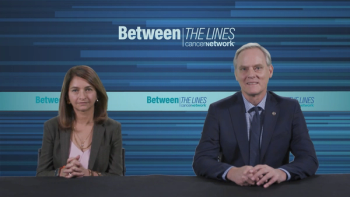
Clinical Scenario 1 With Bispecifics in R/R MM
Panelists discuss how managing a high-risk patient aged 64 years who progressed after 11 months on talquetamab with decreased B-cell maturation antigen (BCMA) surface expression presents challenging options, including switching to GPRC5D-targeting agents like talquetamab, pursuing clinical trials, or potentially using sequential bispecifics despite T-cell exhaustion concerns, while noting that the MonumenTAL-1 trial’s prior BCMA-directed therapy cohort showed promising 12-month progression-free survival, although the data are confounded by intervening therapies between treatments.
Episodes in this series

Clinical Scenario 1 with Bispecifics in Relapsed/Refractory Multiple Myeloma (R/R MM)
This clinical case presents a man aged 64 years with high-risk multiple myeloma featuring 17p deletion and t(4;14) translocation who has received 6 prior lines of therapy, including lenalidomide, carfilzomib, daratumumab, selinexor, and belantamab. After 4 cycles of treatment, he initiated weekly dosing that was subsequently reduced to every 1.5 weeks, achieving a stringent complete response and maintaining minimal residual disease negativity for 11 months before experiencing disease progression. The progression manifested as rising light chains, new lytic lesions, and 50% plasma cells in the bone marrow, with flow cytometry demonstrating decreased BCMA surface expression compared with baseline, suggesting antigen loss as a potential resistance mechanism.
This case highlights the challenging decision-making process when patients progress after BCMA-directed therapy with evidence of antigen downregulation. The decreased BCMA expression suggests that retreatment with another BCMA-targeted bispecific may have limited efficacy, making target switching to GPRC5D-directed therapy a logical consideration. However, the patient’s heavily pretreated status and high-risk cytogenetics add complexity to treatment selection. Options include pursuing compassionate use access to investigational agents, enrolling in clinical trials, or considering GPRC5D-targeted bispecific therapy despite concerns about sequential bispecific use.
The MonumenTAL-1 study included a cohort of patients with prior T-cell–redirecting therapies, which provides some reassurance about the feasibility of sequential bispecific use. However, these data are confounded by the heterogeneity of prior therapies and patient populations. The case emphasizes the need for additional data on sequential bispecific strategies and highlights the importance of combination approaches or “sandwich” therapies between bispecific treatments to potentially restore T-cell function. Clinical trial enrollment remains an important consideration for heavily pretreated patients with evidence of resistance mechanisms, although practical challenges, including washout periods and eligibility criteria, may limit access to investigational therapies.
Newsletter
Stay up to date on recent advances in the multidisciplinary approach to cancer.

















































































